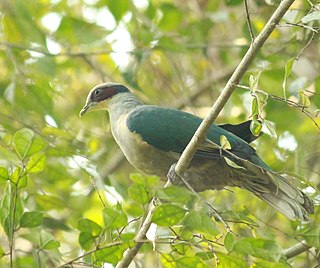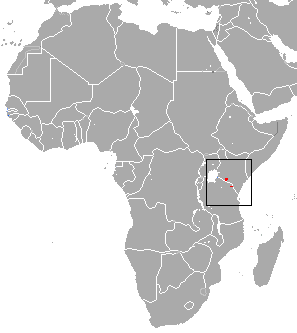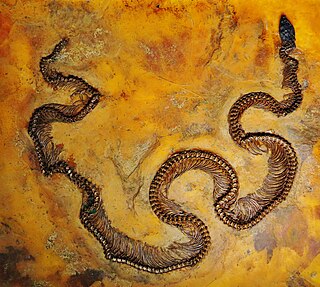
Colubridae is a family of snakes. With 249 genera, it is the largest snake family. The earliest fossil species of the family date back to the Late Eocene epoch, with earlier origins suspected. Colubrid snakes are found on every continent except Antarctica.

Fischer's chameleon, also known commonly as the Nguru blade-horned chameleon and the Nguru two-horned chameleon, is a species of chameleon, a lizard in the family Chamaeleonidae. The species is endemic to Tanzania.

Aliivibrio fischeri is a Gram-negative, rod-shaped bacterium found globally in marine environments. This bacterium grows most effectively in water with a salt concentration at around 20g/L, and at temperatures between 24 and 28°C. This species is non-pathogenic and has bioluminescent properties. It is found predominantly in symbiosis with various marine animals, such as the Hawaiian bobtail squid. It is heterotrophic, oxidase-positive, and motile by means of a tuft of polar flagella. Free-living A. fischeri cells survive on decaying organic matter. The bacterium is a key research organism for examination of microbial bioluminescence, quorum sensing, and bacterial-animal symbiosis. It is named after Bernhard Fischer, a German microbiologist.

Euprymna scolopes, also known as the Hawaiian bobtail squid, is a species of bobtail squid in the family Sepiolidae native to the central Pacific Ocean, where it occurs in shallow coastal waters off the Hawaiian Islands and Midway Island. The type specimen was collected off the Hawaiian Islands and is located at the National Museum of Natural History in Washington, D.C.

The red-eared fruit dove is a species of bird in the pigeon family. It is endemic to the island of Sulawesi, Indonesia.

Fischer's shrew is a species of mammal in the family Soricidae. It is found in Kenya and Tanzania. Its natural habitat is dry savanna.

The Fischer's pygmy fruit bat or Philippine pygmy fruit bat is a species of megabat in the family Pteropodidae. It is monotypic within the genus Haplonycteris. It is endemic to the Philippines. Its natural habitat is subtropical or tropical dry forests.

The Veracruz moist forests is a tropical moist broadleaf forests ecoregion in eastern Mexico.

Palaeopython is an extinct genus of snake from the Eocene of Europe. The genus has been used to refer to large Western and Central European snake vertebrae from the Eocene. P. cadurcensis and the tentatively-referred "P." neglectus originate from France; P. ceciliensis originates from Germany; and P. helveticus originates from Switzerland. A species known from multiple well-preserved specimens found in the Messel Pit of Germany, P. fischeri, was named by Stephan Schaal in 2004, but examination of the genus showed that it represented a distinct lineage; it was renamed Eoconstrictor fischeri in 2020 by Agustín Scanferla and Krister T. Smith. Another species from France, P. filholii, was moved to the genus Phosphoroboa in 2021 by Georgalis, Márton Rabi, and Smith. An additional species, P. sardus, was described in 1901 by Alessandro Portis from the Middle Miocene of Monte Albu. However, a reevaluation of the holotype specimen of this species revealed it to actually belong to an indeterminate acanthomorph fish.
Johann Gustav Fischer was a German herpetologist.

Dipsadinae is a large subfamily of colubroid snakes, sometimes referred to as a family (Dipsadidae). Species of the subfamily Dipsadinae are found in most of the Americas, including the West Indies, and are most diverse in South America. There are more than 700 member species.

Tropidodipsas is a genus of New World snakes of the family Colubridae.

The banded snail sucker is a species of snake of the family Colubridae.

Eoconstrictor is an extinct genus of booid snake, which supposedly had infrared vision, from the Eocene of Germany. The type species, E. fischeri is known from multiple well-preserved specimens found in the Messel Pit of Germany. It was originally named as Palaeopython fischeri by Stephan Schaal in 2004, but examination of the genus showed that it represented a distinct lineage; it was renamed as the new genus Eoconstrictor in 2020. In a subsequent study Georgalis, Rabi & Smith (2021) reinterpreted "Paleryx" spinifer from the Eocene Geiseltal Lagerstätte as the second species belonging to the genus Eoconstrictor. Palci et al. (2023) named the third species belonging to this genus, E. barnesi described on the basis of fossils from the Geiseltal Lagerstätte.

Geophis annuliferus, also known as the western snail-eating snake, is a snake of the colubrid family. It is endemic to Mexico.

Geophis sartorii, also known commonly as Sartorius' snail-sucker and the terrestrial snail sucker, is a species of snake in the family Colubridae. The species is native to southern North America and Central America. There are two recognized subspecies.
Tropidodipsas guerreroensis, the Guerrero snail sucker, is a species of snake in the family, Colubridae. It is found in Mexico.
Tropidodipsas repleta is a species of snake in the family, Colubridae. It is found in Mexico.
Tropidodipsas tricolor, the tricolor snail sucker, is a species of snake in the family, Colubridae. It is found in Mexico.
Tropidodipsas zweifeli, Zweifel's snail-eating snake, is a species of snake in the family, Colubridae. It is found in Mexico.














